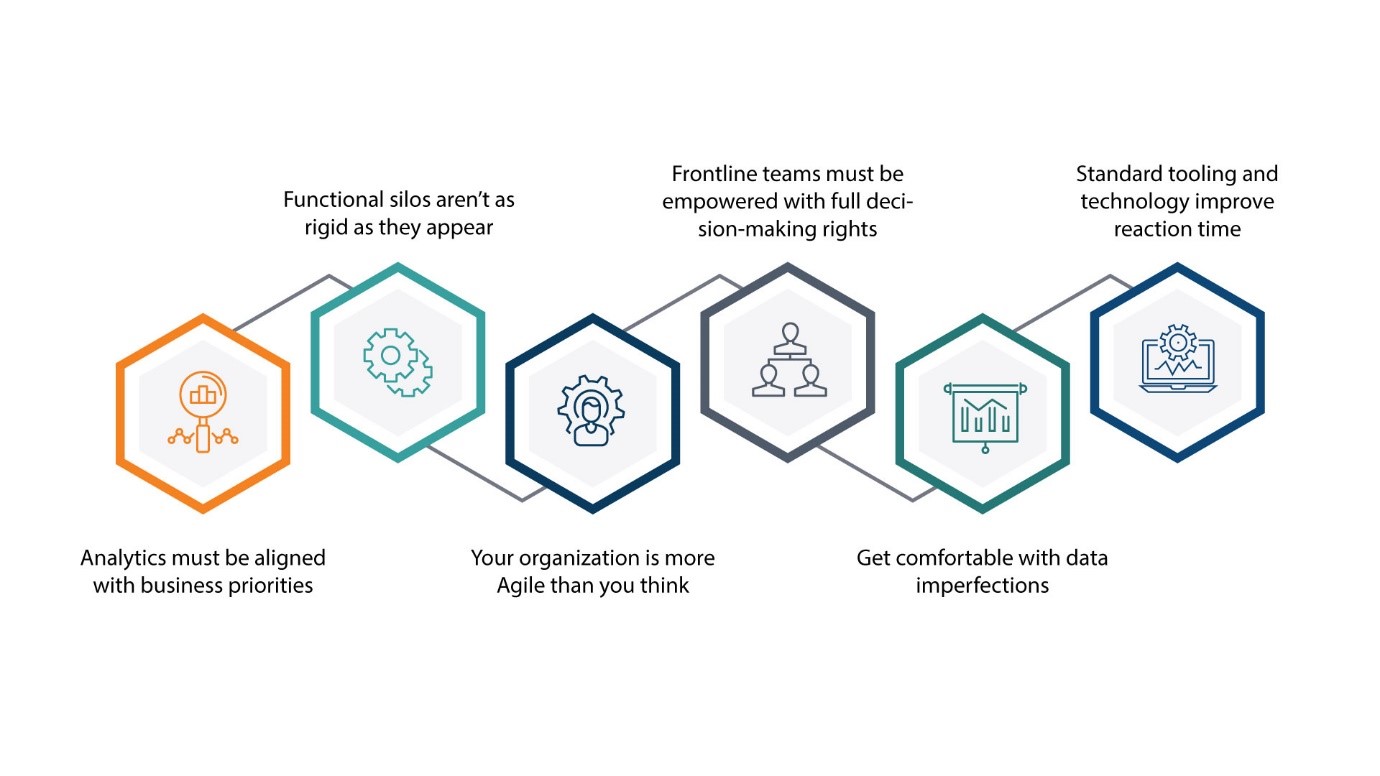Even before the COVID-19 crisis, businesses were increasingly embracing Artificial Intelligence (AI) and Advanced Analytics. The pandemic, however, introduced a new element of urgency to the need for these advanced AI and analytics-driven predictive and problem-solving technologies – to safeguard themselves and stakeholders against continual uncertainty, the economic repercussions following community lockdowns, and consumer apprehension-led business disruptions.
To quote McKinsey, “Analytics support numerous urgent tasks facing businesses today: forecasting demand, identifying potential supply-chain disruptions, targeting support services to at-risk workers, and determining the effectiveness of crisis intervention strategies, to name a few.”
In this blog, I have listed the six most important Analytics-related lessons that the pandemic has taught businesses across the globe and analyzed the effect each of these six lessons is already having on organizations.
The figure below lists these six lessons:

The effect each of these six lessons is having on organizations is as follows:
- Analytics must be aligned with business priorities – A lot of times we are so busy adding the ‘next big thing’ into our stack or responding to customer-driven demands, that we tend to overlook the goal of improving our broader footprint. In fact, a McKinsey research has found that only 30% of organizations align their analytics strategies with their broader corporate strategies, let alone leverage the benefits of advanced data analytics tools.
Businesses that have scaled AI effectively are almost four times more successful than others in aligning these two strategies. The coronavirus pandemic has necessitated that companies respond rapidly to the challenges it is throwing up by ‘building new data streams, reporting on business-critical issues to guide near-term decisions, and developing longer-term views of data to understand what the future may hold for their company, customers, and suppliers’ – all made possible through analytics. - Functional silos aren’t as rigid as they appear – Before the pandemic, organizations that were realizing higher returns from AI and scaling it more broadly were likelier to assemble agile cross-functional teams to address business problems. However, during the pandemic, nearly 62% organizations have assembled cross-functional crisis-response teams with relevant stakeholders to develop analytics solutions for quicker response – regardless of analytics maturity. Truly pervasive analytics is, therefore, the go-to tool for making cross-functional connections, enabling root cause analysis and encouraging pre-emptive action to mitigate risks.
- Your organization is more agile than you think - Agile delivery methods can create a minimum viable product in weeks. For instance, iterative development sprints free teams to quickly test ideas, get feedback from users in the early stages, and adjust accordingly. Studies suggest organizations that had not adopted or trained employees on agile practices are now (during the coronavirus crisis) applying agile concepts to gain the answers they need quickly.
- Frontline teams must be empowered with full decision-making rights – Shifting to data-driven decision making from the top-down approach has traditionally been a challenge for many organizations since it is the opposite of what many have historically done. However, as part of crisis-response efforts, organizations that are now analytics enabled are readily empowering employees with decision-making authority.
- Getting comfortable with data imperfections and getting ahead of the model drift – The pandemic has compelled leaders to acknowledge that existing data too can generate meaningful insights. Leaders now are more willing to work with the ‘best information available’ with Power BI helping refine the concept of what ‘best available information’ is.
In fact, Power BI can help organizations leapfrog into what is – in some ways – an intellectual, data-driven arms race centered around who is going to come out at what position in this unique time of world history. Also, who has the most insight and the ability to see around the corners when it comes to forecasting, and who can optimize all the pieces and parcels of data they have. An organization that meets these criteria will come out ahead of the curve and achieve the highest degree of potential it is capable of.
The coronavirus emergency is also pushing businesses to evaluate how capable their well-honed, calibrated analytical models are in overcoming new data challenges; those that are emerging due to the pandemic-induced economic and consumer behaviour shifts. - Standard tooling and technology improve reaction time – As the COVID-19 crisis tightens its hold, organizations across industries are standardizing data, accelerating data ingestion, and introducing consistency in model development by making common tools and technologies available to their data and analytics professionals. According to McKinsey’s latest AI survey, “organizations reporting widespread use of AI were 4.2 times more likely than others to have standard tool sets (76% versus 18% of others).
The way forward
The pandemic has propelled rapid changes within organizations to ensure they survive its challenges. While certain challenges will take time to get resolved, leaders who understand the implications of these lessons know that the future will be very different from the past. Such leaders will use these learnings to build new and pragmatic business models (and ways of working) with the potential to help businesses survive and thrive.
![[Next Read] 5 ways food manufacturers can future-proof operations post-pandemic](https://no-cache.hubspot.com/cta/default/494838/ce9bba08-ffeb-44fe-a350-6d70e45180c5.png)
